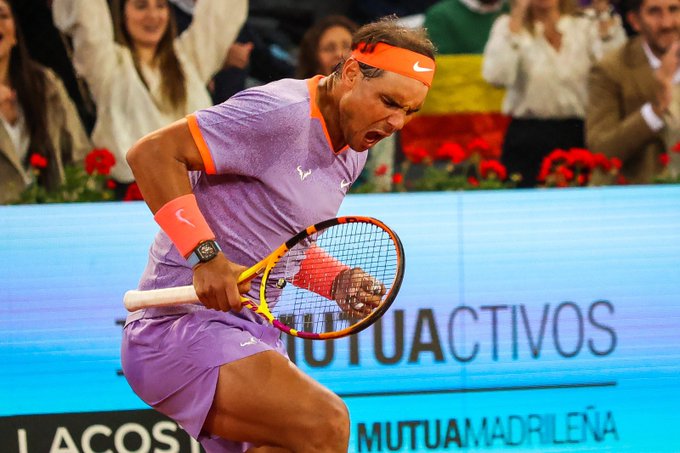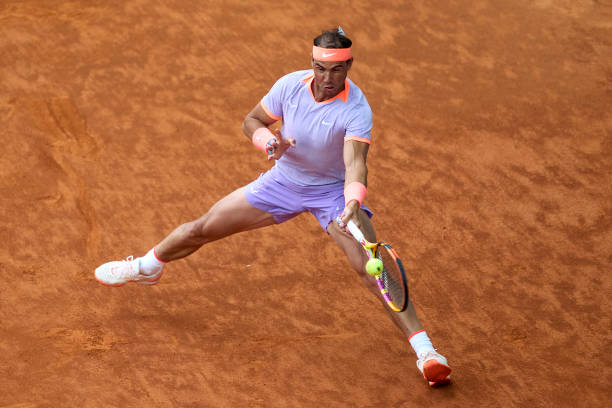
What to make of Rafael Nadal and his clay-court season so far? As an unseeded player, does he still have a chance of adding another crown to his glittering collection of 14 Grand Slams at Roland-Garros? Can he play best of five-set matches over a duration of seven games in a row? As Nadal trudges through the autumn of his illustrious career, there are enough questions revolving around his form.
On expected lines, Nadal looked rusty and out of sorts at the Barcelona Open, where he bowed out in the second round to Alex de Minaur. There were positive signs for the Nadal camp in his next tournament – Madrid Masters – where he didn’t just usurp de Minaur, but went on to reach the last 16. Eventually, he lost out to the big-serving Czech Republic player, Jiri Lehecka.
He notched up one more victory in his comeback trail by defeating Zizou Bergs in the first round of the ongoing Rome Masters. So, how to gauge Nadal’s performance versus Bergs? Probably, we have to do some number-crunching to get a better picture. For starters, Bergs played much better than what his ranking of 108 would suggest. In fact, barring the first serve percentage, Bergs led Nadal on every single count in that set. It was partly because of Nadal’s game being below par. However, to Bergs’ credit, he whipped some potent forehands and backhands, alongside incisive serving.
After the opening set, Nadal did take a small break. When he returned, Nadal had a completely different mindset. We witnessed enough glimpses of the old Nadal in the first four games of the second set and he was rewarded with an early break. He nailed a cross-court backhand winner or two. More importantly, there was more sting attached to his forehand, evidenced by how he whipped an inside-out forehand with heavy top-spin in the inaugural game of the set.
Although Nadal’s levels dropped a bit as the set progressed, it was crystal clear that he had gained the momentum. Just a peek into the stats and you could notice it was the exact opposite of the opening set. From first serve percentage, first serve and second serve points won to returns, Nadal had an advantage. The legendary player also cut down on his unforced errors to just three and cracked more than enough winners of the forehand side.
The final set too followed a similar pattern. Nadal touched noteworthy heights in the first few games and aptly broke his opponent. Once more, Nadal’s level slipped at the back-end of the set but he did enough to hold off his opponent and close out the match. During the initial phase of the last set, he was certainly pumped up, exemplified by a few of his celebrations.
That kind of intensity was visible in his tennis as well. At 0-15, 0-1, Nadal recovered from a tumble and worked his way through winning the long rally. The crowd roared in delight as Nadal did a fist-pump. More importantly, he was working his opponent side-by-side with down-the-line backhand and cross-court forehand. By then, Bergs’ speed on the forehand side also had dropped to 125 kph from 134 kph, as he made some costly unforced errors.
So, what Nadal had to say about the match? “The line is going up, without a doubt. So yeah, I mean, happy to be where I am because one month ago for me was almost impossible to think that I would be able to play in Barcelona, then in Madrid and now being here in Rome.”
The final verdict is, just when you feel Nadal has next to no chance of winning another Major, he has shown sparks of brilliance. Basically, Nadal needs more matches under his belt to dust off the inconsistency bug. And for that to happen, he has to chisel his way through some more rounds in the Rome Masters. A few more victories before the French Open wouldn’t just help him iron out the flaws but also boost his confidence. Even for one of the greatest athletes, the saying – winning is a habit – is akin to a turbo-charged tonic.
5 @ 5 With Boria ll LIVE https://t.co/2P1st9R7fw
— RevSportz (@RevSportz) May 6, 2024




